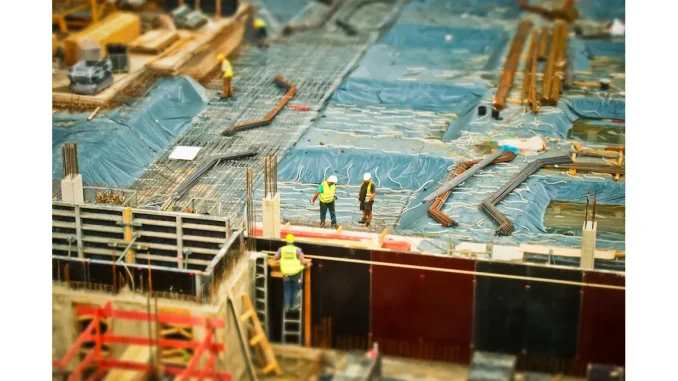
In a time characterised by economic instability and unexpected disruptions, the Construction Leadership Council’s Material Supply Chain Group has unveiled its latest report, offering a cautiously optimistic outlook for the construction industry. This comprehensive report delves into the sector’s resilience, minor material availability issues, price stability, and the collaborative efforts required to ensure sustained growth.
The report opens on an encouraging note, underscoring that overall product availability remains robust. Although there are isolated shortages in specific materials such as concrete roof tiles, aircrete blocks, doors, and certain timber products, these disruptions are regional and specific to certain manufacturers. A spokesperson for the Council assures, “We expect these issues to be temporary.” Notably, the report highlights a stabilisation in prices, a favourable development for an industry still reeling from the economic aftershocks of the COVID-19 pandemic. Most construction materials have remained affordable, with the notable exceptions being PIR insulation and some timber products, which have experienced significant price increases. This price stability forms a crucial foundation upon which the industry can rebuild and flourish.
The report also addresses the complexities of international shipping, particularly the modest impacts resulting from hostilities in the Middle East. Supply lines between Asia and the UK, routed via the Red Sea, have seen some increases in costs and delivery times. However, these challenges have been manageable. “We’ve been closely monitoring the situation, and while there have been some increases, they are modest and manageable,” notes the spokesperson. Intriguingly, the industry’s previous experiences during the pandemic have equipped companies with the skills needed to navigate these challenges effectively. The ability to adapt and ensure timely delivery of materials has become a hallmark of the construction sector’s resilience.
The first half of the year brought its own set of challenges, with high interest rates and adverse weather conditions slowing down both activity and demand within the construction sector. Yet, there is a glimmer of hope. The report highlights a cautious optimism for recovery in the latter half of the year, with a particular focus on potential growth in 2025. One contractor shared a positive outlook, stating, “We’re starting to see RMI (Repair, Maintenance, and Improvement) work picking up again. It’s a good sign, especially considering the tough start to the year.” This resurgence in RMI work is seen as a precursor to broader recovery, indicating that the sector is slowly but surely regaining its footing.
A significant portion of the report underscores the need for government intervention to drive recovery. The Council calls for swift action from the new government to support UK construction through measures that promote housebuilding, infrastructure development, energy efficiency retrofits, and planning reforms. “We need the new government to act quickly,” emphasises the spokesperson. Moreover, the report stresses the importance of accurate forward forecasts from manufacturers to ensure that capacity aligns with demand. An industry expert elaborates, “Accurate forecasting is essential. Without it, we risk either overproduction or shortages, both of which can be detrimental.” The Council continues to advocate for proactive planning and open lines of communication within the supply chain. This collaborative approach, honed during the pandemic, is deemed crucial for maintaining a healthy and productive UK construction industry. “Collaborative, ongoing communication throughout the whole supply chain is mutually beneficial,” the spokesperson concludes.
The Construction Leadership Council’s report provides a snapshot of an industry in a state of cautious recovery. The stability in product availability and prices is encouraging, yet the isolated shortages and price fluctuations in PIR insulation and timber underscore the fragility of the supply chain. The modest impact of Middle Eastern hostilities on shipping is a testament to the industry’s resilience. However, high interest rates and adverse weather conditions highlight the multiple factors that can influence construction activity. The report’s findings suggest that while the sector is on a path to recovery, it remains susceptible to various external pressures.
Looking ahead, the construction industry faces several potential developments that could shape its trajectory. Anticipated rate cuts from the Bank of England could provide a much-needed stimulus for key sectors, especially if combined with government measures to support housebuilding and infrastructure projects. Manufacturers will need to focus on accurate forecasting to avoid the pitfalls of overproduction or shortages. The lessons learned during the pandemic about the importance of communication and collaboration will continue to be vital. Stakeholders must remain vigilant and maintain open lines of communication to navigate the challenges that lie ahead.
In terms of materials, the industry might see further price stabilisation, except for areas like PIR insulation and timber, which could remain volatile. Continuous monitoring of international shipping routes will be crucial, particularly if geopolitical tensions persist. Overall, the construction industry is poised for a period of cautious optimism. The collaborative efforts of all stakeholders—from government bodies to individual contractors—will be essential in navigating the challenges and seizing the opportunities that the future holds. The Construction Leadership Council’s report serves as a reminder that while the path to recovery may be fraught with obstacles, the industry’s resilience and adaptability can pave the way for sustainable growth.


Be the first to comment